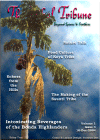Nature Talk
|
The tribal people are children of Nature. Those who have migrated to the urban or industrial area for better earning have compromised with the suffocating conditions of the slum life, sans some fortunate tribal families in while collar jobs. The natural carefree life in the hill-forest habitat, have infused in them a sense of social autonomy. Ecological hardship in homeland and urban shanties are quite different in nature. In homeland, they transact with the nature that they know very intimately and intuitively. They fail to understand the ways of behavior of the urban people and often forced to live a degraded life. A nineteenth century Bengali writer while obscuring the tribal people of Palamou district (Jharkhand) had remarked, "the wild people are beautiful in their forest habitat as a child is beautiful in its mother’s lap". Their scanty clothes, antique ornaments, unpolished expression and unfamiliar social norms are quite strange for urban life. Many non-tribal educated persons working in the tribal areas have opined that the tribal people have no marriage regulation, they are promiscuous, eat anything, are very shabby, have no sense of some etc. these have stemmed from utter ignorance. Those who have love for nature and are human have sensed beauty among these children of nature. In this issue we have included two articles on food and drink of two aboriginal communities living in the mythological ‘Dandakaranya’ area on the Eastern Ghats. Although the eco-system is same and food availability is also similar, each tribe has its own choice and manner of consumption. Liquor consumption is a part of their food system and to them it is not addiction. Any addictive habit does not have ritual support, as the article on the Koya will inform, how these primitive depend on particular food item and also prohibit the same for certain apprehension.
The legend and myth are ever attracting. Each tribe has its own stories of origin. In this issue three such stories have been narrated on the origin of Saunti people of Orissa . |
Photographs : Koya Drummer by Hrudaya Panigrahi
References :




